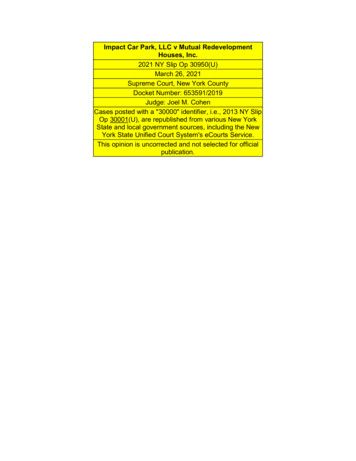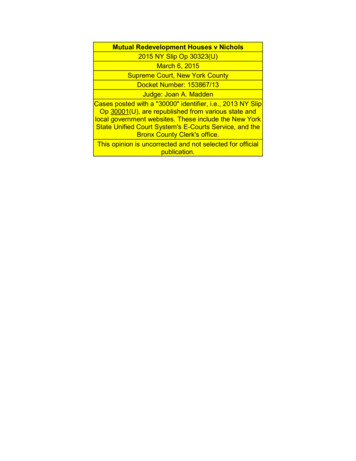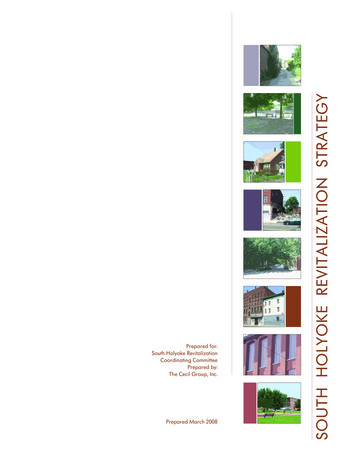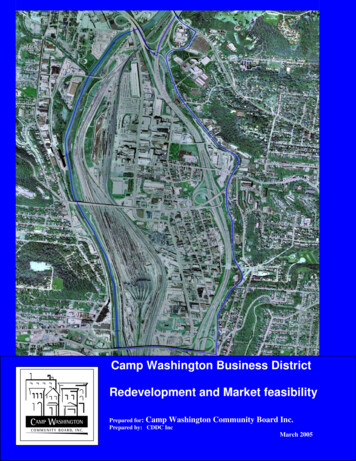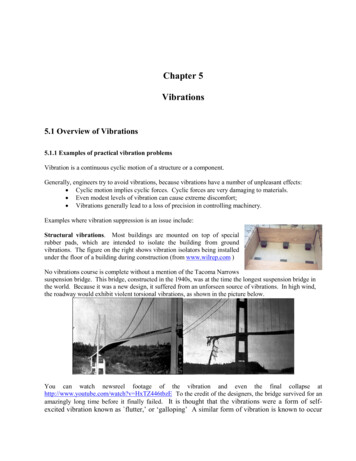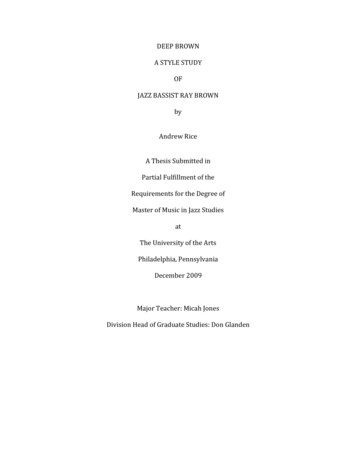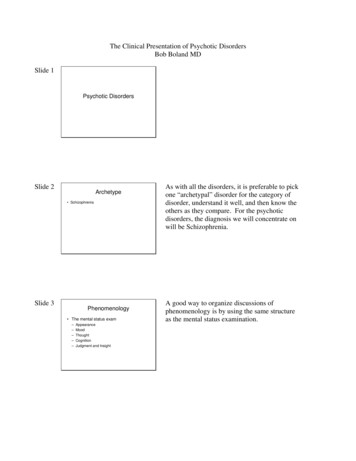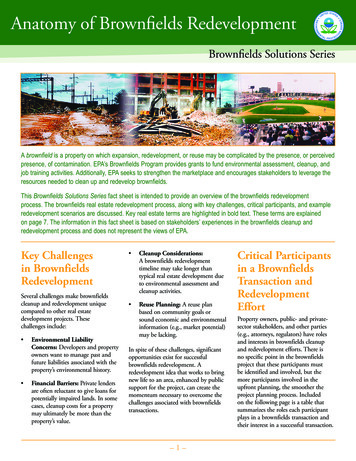
Transcription
Anatomy of Brownfields RedevelopmentBrownfields Solutions SeriesA brownfield is a property on which expansion, redevelopment, or reuse may be complicated by the presence, or perceivedpresence, of contamination. EPA’s Brownfields Program provides grants to fund environmental assessment, cleanup, andjob training activities. Additionally, EPA seeks to strengthen the marketplace and encourages stakeholders to leverage theresources needed to clean up and redevelop brownfields.This Brownfields Solutions Series fact sheet is intended to provide an overview of the brownfields redevelopmentprocess. The brownfields real estate redevelopment process, along with key challenges, critical participants, and exampleredevelopment scenarios are discussed. Key real estate terms are highlighted in bold text. These terms are explainedon page 7. The information in this fact sheet is based on stakeholders’ experiences in the brownfields cleanup andredevelopment process and does not represent the views of EPA.Key Challengesin BrownfieldsRedevelopmentSeveral challenges make brownfieldscleanup and redevelopment uniquecompared to other real estatedevelopment projects. Thesechallenges include: Environmental LiabilityConcerns: Developers and propertyowners want to manage past andfuture liabilities associated with theproperty’s environmental history.Financial Barriers: Private lendersare often reluctant to give loans forpotentially impaired lands. In somecases, cleanup costs for a propertymay ultimately be more than theproperty’s value. Cleanup Considerations:A brownfields redevelopmenttimeline may take longer thantypical real estate development dueto environmental assessment andcleanup activities. Reuse Planning: A reuse planbased on community goals orsound economic and environmentalinformation (e.g., market potential)may be lacking.In spite of these challenges, significantopportunities exist for successfulbrownfields redevelopment. Aredevelopment idea that works to bringnew life to an area, enhanced by publicsupport for the project, can create themomentum necessary to overcome thechallenges associated with brownfieldstransactions.–1–Critical Participantsin a BrownfieldsTransaction andRedevelopmentEffortProperty owners, public- and privatesector stakeholders, and other parties(e.g., attorneys, regulators) have rolesand interests in brownfields cleanupand redevelopment efforts. There isno specific point in the brownfieldsproject that these participants mustbe identified and involved, but themore participants involved in theupfront planning, the smoother theproject planning process. Includedon the following page is a table thatsummarizes the roles each participantplays in a brownfields transaction andtheir interest in a successful transaction.
Roles and Interests of ParticipantsThe Real ty OwnerBrownfields redevelopment oftenrelies on strong coordinationamong stakeholders including localcommunities; local, state, and federalgovernments; private parties; andnonprofit organizations. Successfuldevelopment of brownfields can beenabled or accelerated when thesestakeholders work together to assessand clean up the property and pursuea common redevelopment goal.RoleInterestSell or develop theproperty Want to receive a fair value of their property depending onthe extent of environmental contamination Want to manage any liability concerns upfrontPublic-SectorStakeholders Local GovernmentsCommunity GroupsEPA Grant RecipientsNonprofitOrganizationsRedevelop theproperty froma communityand economicdevelopmentperspective Want to see the project succeed in terms of revitalizingblighted properties and generating economic or communitygrowth May want the successful property assessment, cleanup, andreuse to enhance the community’s imagePrivate-SectorStakeholders InvestorsLendersDevelopersInsurersProvide resources todevelop the property Want to see the project succeed in terms of revitalizingblighted properties and generating economic or communitygrowth Want to earn an appropriate return on investment May want to tie the property redevelopment into a largerredevelopment plan for the neighborhood or communityOther Parties Attorneys EnvironmentalConsultants State and FederalRegulatorsProvide technical,regulatory, or otherguidance Want to ensure that the property is cleaned up and safe forappropriate levels of use and/or reuse Want to alleviate future environmental concerns on thepropertyTypical Steps in the Redevelopment ProcessCleanup andDevelopmentPre-DevelopmentSecuring the Deal· Indentify and Refine aRedevelopment Idea· Conduct Due Diligence· Secure Accessto the Property· Identify Sources ofFinancing· Contract Negotiation· Secure Financing· Establish a RemedialAction Plan· Secure the Property andFormal CommitmentThe redevelopment process generallyfollows four steps: 1) Pre-development;2) Securing the Deal; 3) Cleanupand Development; and 4) PropertyManagement. Within each of thesesteps, there are multiple activities thatmay occur, and the order of theseactivities may vary. As brownfieldsredevelopment projects vary greatly intheir complexities and scope, a greateremphasis will be placed on differentparts of the process depending onwhich type of redevelopment scenariooccurs. Brownfields redevelopmenttypically follows one of three scenarios:private-led, public-private partnership,or public-led. These three scenarios arediscussed on page 5.· Approvals· Cleanup· Integrate Cleanup andConstruction· Property Sale or Lease· Completion and ies laythe foundationfor a roject byidentifying andrefining the redevelopment idea;conducting due diligence to assess theextent of contamination at the property;identifying potential funding sources;and resolving numerous other issuesrelated to the property’s redevelopment.The pre-development activities are aniterative rather than a linear process.–2–PropertyManagement· Long-Term Operationsand Maintenance ofRemedial SystemsIdentify and Refine a RedevelopmentIdea. To begin the pre-developmentprocess, a developer may reexamine adevelopment idea several times beforethe project makes sense, from both afinancial and environmental standpoint.In a private-led redevelopment scenario,the developer typically generates andrefines the redevelopment idea, whilein the public-led redevelopmentscenario, the community inputdrives the redevelopment idea. Inidentifying a redevelopment idea, oneof the first steps in the brownfieldsredevelopment process is to identifyand assess potential reuses for theproperty. Early determination of theproperty’s reuse will ensure that cleanup
efforts complement the reuse goal andthat stakeholders are invested in theredevelopment process. All criticalstakeholders should be assembled tofacilitate communication and elicitsupport for the project. Input gatheredthrough stakeholder meetings canbe used to conduct a reuse planningeffort to evaluate historic use patterns;examine existing planning and zoning;and refine potential redevelopmentideas.Conduct Due Diligence. Duediligence involves a variety of activitiesin advance of purchasing a propertyas well as activities specific to theenvironmental components of theredevelopment. These activities typicallyinclude conducting property andenvironmental assessments, researchingland and building titles for the property,and continuing communications withkey stakeholders about the plannedredevelopment. When reviewingproperty reuse assessments, theassessments typically consider thehighest and best use of a property,environmental factors, availablefinancial tools, and local stakeholderconcerns. The highest and best usefrom a developer’s perspective may varyfrom what the community considersthe best use of the property. Potentialcontamination on the property maypresent obstacles to the developer’shighest and best use for the property.The project developer or EPA grantrecipient may also prepare a marketanalysis or feasibility study to evaluatelocal and regional economic and realestate conditions and characterize themarket demand for various real estateproducts. During the due diligenceprocess, a project developer will alsolikely conduct a pro forma analysis todetermine the economic viability of thedevelopment.Identifying the presence and extent ofcontamination is essential to evaluatingrisk, limiting liability, and determiningan appropriate reuse. If not alreadydone, a Phase I environmentalassessment should be performed toidentify the presence, type, and extentof contamination that may exist onsite.If required, a Phase II assessmentmay be conducted to sample or testfor specific hazards that may havebeen identified in Phase I and to helpdevelop a remedial action plan.Secure Access to the Property. Accessto the property must be secured fromthe property owner before beginningassessment activities. A plan forobtaining property control or propertyownership should be identified ifthe property owner is not an activeparticipant in the redevelopmentprocess.Identify Sources of Financing. Acombination of private- and publicsector funding may be used to financeassessment, remediation, purchase,and redevelopment activities. Thesefunding sources may include: local,state, and federal governmentprograms that offer tax credits, taxabatements, TIF districts, grants,subsidies, bonds, or loans; propertyowners; developers; investors; andnonprofit organizations. Municipaleconomic development agencies and/orstate brownfields programs are likelysources of information for brownfieldsredevelopment financing.Securing the DealSecuring theDeal can beginonce the preSecuring the Dealdevelopmentstep has yieldeda decisionto purchasethe property andcontinue with the project. In order tosecure the deal, contract terms mustbe negotiated, financing secured, anda decision must be made on how tomanage the environmental liability.Once all of these steps are satisfied, aformal commitment is made to moveforward.–3–Contract Negotiation. A brownfieldsproject may have complications thatmust be resolved between the buyer andseller that stem from environmentalconcerns. During the contractnegotiation, a term sheet is oftenused to sort out what responsibilitiesthe buyer and seller will each take inthe property transfer. For example,if the property has existing buildingsthat will be reused, this may includenormal property and building costslike repairing roofs or HVAC systems.Negotiations also include determiningwhere the responsibility for remediationlies and who will manage the liabilityonce the redevelopment is completed.Other issues requiring negotiationinclude establishing liability for variousaspects of the cleanup including onsite vs. off-site concerns and agreeingon long-term responsibility for themaintenance of the remediation andinstitutional controls, if applicable.Secure Financing. One of thedeveloper’s roles is to provide financingto develop the property. To ensurethat cleanup and redevelopment arenot hindered by a lack of funding, allpublic and private funding sources(e.g., grants, loans) identified in thepre-development step should besecured. If necessary, a nonprofit, trust,or other fund may be established toreceive and distribute this funding.In many instances, debt financingis utilized, where loans are securedthrough a financial institution for theredevelopment. Private investors mayalso back developers through equityfinancing. Public financing may beutilized for many components of theredevelopment, including buildingdemolition, infrastructure development,and cleanup activities.Establish A Remedial Action Plan.In brownfields redevelopment, it isdifficult for a property to transferowners if the remediation costs are notquantified. Therefore in most situationsa property is completely characterizedand a remedial action plan is put inBold terms are defined on page 7.
place. This process can either be doneby the buyer or the seller.Securing the Property and FormalCommitment. If the property isnot owned by the entity performingcleanup and redevelopment, it may beobtained through a purchase or saleagreement, or involuntary acquisitionmethods such as foreclosure. Duringthe formal commitment, contracts anddocuments are signed and exchanged.Once obtained, any zoning changes orvariances that may be required for theplanned reuse should be pursued (e.g.,changing the property’s zoning fromindustrial to commercial).Cleanup and DevelopmentCleanup andDevelopmentoccurs onceCleanup andthe planningDevelopmentprocesseshave beencompleted. Thisstep encompassesreceiving construction approvals;conducting cleanup and construction;integrating cleanup and constructionactivities; and completing theredevelopment signified by theproperty’s sale or lease, includingsecuring tenants.Approvals. Prior to construction, allland use and construction approvals arenecessary. In order to receive approvals,specifications of the buildings and siteplans have been approved and permitshave been secured.Cleanup. Property cleanup isconducted based on the remedial actionplan. Depending on the type, quantity,and toxicity of contamination foundonsite, cleanup activities may includesoil, surface water, or ground waterremediation. If an entity that did notcontribute to the contamination isperforming the remediation, it may doso through a state voluntary cleanupprogram, which may limit liabilityassociated with any residual or newlydiscovered contamination after cleanup.A cleanup may be considered completewhen local, state, or federal regulatoryclosure (e.g., a No Further ActionLetter) is issued.Integrate Cleanup and Construction.Based on assessment activities, plannedcleanup actions, and stakeholderinput, developers are typically able tointegrate cleanup and constructionactivities. Engineers for cleanup andconstruction activities have developeddetailed plans for streamlining theprocess and ensuring all issues areresolved so that
cleanup and redevelopment, it may be obtained through a purchase or sale agreement, or involuntary acquisition methods such as foreclosure. During the formal commitment, contracts and documents are signed and exchanged. Once obtained, any zoning changes or variances that may be required for the planned reuse should be pursued (e.g.,
